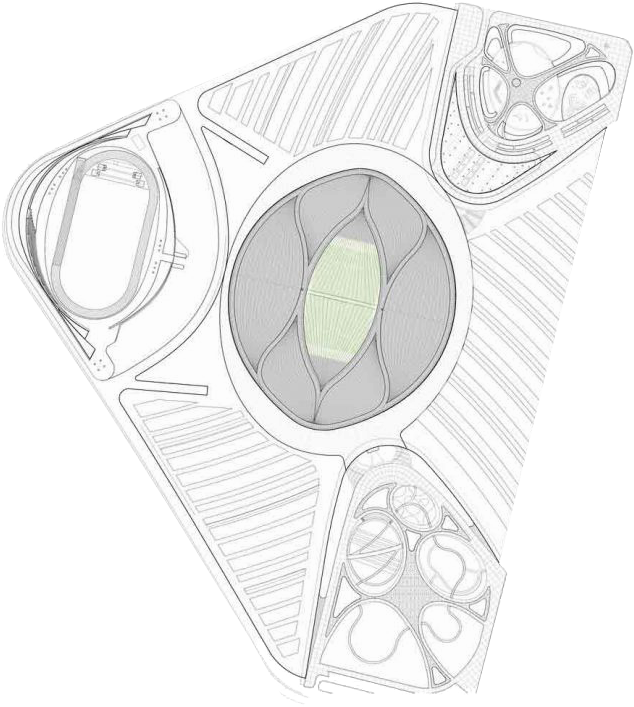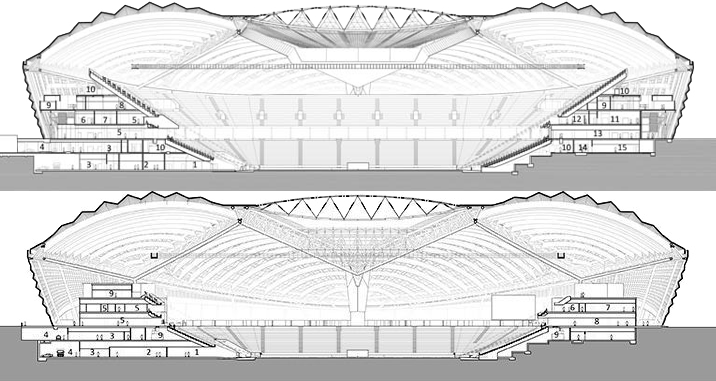Al Janoub Stadium (Al Wakrah Stadium)
| Capacity | 44 325 |
|---|---|
| Country | Qatar |
| City | Al-Wakrah |
| Clubs | Al-Wakrah SC |
| Inauguration | 16/05/2019 (Al Sadd - Al-Duhail, 1-4) |
| Construction | 03/2014 - 30/04/2019 |
| Cost | € 587.3 million |
| Design | Zaha Hadid Architects, AECOM |
| Contractor | MIDMAC, PORR Qatar, Six Construct |
| Address | 5H5F+WJ Al Wukair, Qatar |
Advertisement
Al Janoub Stadium – stadium description
Just 23 km from central Doha and 15 km from the capital's southern limit sits the very first stadium purpose-built for the 2022 World Cup. While nominally placed in Al Wakrah, the stadium and its precinct are physically within Al Wukair, a municipality west of Al Wakrah.
Here, over 58 hectares were earmarked for a major leisure precinct, including the main stadium, two more training stadia and massive 20 hectares of public green areas with some 800 trees. This makes it one of Qatar's largest parks.
In this unique spot, beside a freshly-built highway junction, a stadium with net capacity of 40,000 people was envisioned, meant to become an instant landmark with total height of 48 meters in otherwise low-rise, low-density area.
Back in 2013 the design contract was signed with Zaha Hadid, for whom it was to be the very first football stadium ever created. Due to its one-off form, it gained global recognition instantly, not necessarily for the right reasons. Nicknamed the 'vagina stadium' by tabloid media, it was also seen as a feminist manifesto by others. But far more compelling is the official interpretation of its design, with strong maritime theme.
 It's inspired by the dhow, a traditional Qatari fishing boat. On the one hand its flowing white outer form resembles sails moved by wind. On the other, the inner side of the roof with strong use of engineered timber strongly resembles the dhow's hull. And finally, its near-liquid form is something Zaha Hadid Architects have been famous for globally.
It's inspired by the dhow, a traditional Qatari fishing boat. On the one hand its flowing white outer form resembles sails moved by wind. On the other, the inner side of the roof with strong use of engineered timber strongly resembles the dhow's hull. And finally, its near-liquid form is something Zaha Hadid Architects have been famous for globally.
While the exterior was splendidly retained during final design works and optimisation, inside it's not quite the same. The use of timber was scaled down drastically compared to early renditions and almost all of the symmetric multi-domed roof is supported by traditional steel skeleton.
With weight of 7,500 tons, it's quite significant for a stadium of this scale, but at the same time it's also absolutely unique, consisting of six interwoven domes. While immensely impressive overall, the visual impact inside is somewhat diminished by technical platform hovering under the domes, holding floodlights in optimal positions.
In engineering terms it's still a thing to behold, for example with its retractable roof – very first of its kind. While based on the cable-membrane system known before, it works differently. All such systems installed before had a garage hovering above centre field and membrane moving radially. Meanwhile here there's a garage above each goal and the sliding roof moves towards the oculus beam, hanging 50 meters above the field. The teflon-coated PVC roof takes 30 minutes to open/close.

The auditorium is perhaps most conventional, with two continuous rings of seating, each of similar scale. One major difference between them is that the lower ring is made of reinforced concrete, while the upper largely consists of steel. This, of course, comes as an effort to make the upper stands demountable. Following the 2022 World Cup the stadium is to be scaled down to over 20,000 seats and remainder is to be shipped overseas. Place left between remaining auditorium and the roof is to be dedicated to corporate hospitality and leisure uses.
As you can see from the images, the stadium is entirely enclosed, offering no natural ventilation. While usually stadia have some form of opening to ensure air exchange between the stadium and its surroundings, here one of the goals was to control temperature of the interior throughout events. That's why air conditioning inside creates a 'cool bubble' inside by flowing chilled air onto the field and stands, then rechilling it in internal circulation. This effort is aided by the sliding roof, as well as the aerodynamic form protecting audience from hot winds.

Officially construction of the stadium began in January of 2016 and was to end in November of 2018. However, this contractual timeline is only part of the story. First enabling works on site were launched as early as March of 2014, starting excavation of huge amounts of soil (460,000 m3) and installation of a 28,000-m3 concrete foundation slab. Due to numerous design interventions, the stadium was not delivered in the original deadline, but there was also no pressure on the investor to deliver it before 2018's end.

With Qatar's horrible reputation on worker welfare, we tried to find as much information on deaths around this specific project. We were able to confirm only two fatalities, both concerning very young workers and both treated as accidents. While surely tragic, this doesn't differ from similar projects of such scale carried out around the world. That said, we have no way of verifying information first hand.
Advertisement
Pictures
-

2022 © Go Qatar 2022 
2022 © Go Qatar 2022 
2022 © Go Qatar 2022 
2022 © Go Qatar 2022 
2021 © Go Qatar 2022 
2021 © Go Qatar 2022 
2021 © Go Qatar 2022 
04.2019 © Supreme Committee for Delivery and Legacy 
04.2019 © Supreme Committee for Delivery and Legacy 
05.2019 © Abdullah bin Nasser bin Khalifa Al Thani 
05.2019 © Supreme Committee for Delivery and Legacy 
05.2019 © Supreme Committee for Delivery and Legacy 
05.2019 © Supreme Committee for Delivery and Legacy 
03.06.2022 © J R Montejo 
04.2019 © Supreme Committee for Delivery and Legacy 
04.2019 © Supreme Committee for Delivery and Legacy 
04.2019 © Supreme Committee for Delivery and Legacy 
04.2019 © Supreme Committee for Delivery and Legacy 
04.2019 © Supreme Committee for Delivery and Legacy 
05.12.2019 © QATAR PLACES 
04.12.2021 © ChanaBruz 
17.05.2019 © عـادل بن احمـد 
2021 © Go Qatar 2022 
2019 © Ben Williams 
25.08.2022 © caminoal2022 
25.08.2022 © caminoal2022
Related news
2023
2022
-

Qatar 2022: World Cup concluded!
On Sunday, everything became clear. The World Cup winner, after a 36-year hiatus, is once again Argentina, who defeated France in a penalty shootout at the end of a exciting match. On Saturday, Croats won a bronze medal following a victory over Morocco. So, let us now wrap up the World Cup from the stadiums perspective.
-

Qatar 2022: Final showdown excitement ahead!
The World Cup is slowly coming to an end, but there are still two key matches to be played that will decide who will bring home the medals and of what metal. Croatia and Morocco will face each other for the bronze on Saturday and Argentina and France in the grand final on Sunday. Expect a lot of action!
-

Qatar 2022: Check out our coverage of the World Cup!
The World Cup can be entertaining. There is no shortage of beautiful goals, excitement until the 100th (sic!) minute, controversial refereeing calls and defeats for the favourites. But, we are especially interested in Qatar's stadiums, and if you somehow missed the events of recent weeks, we are here to help.
-

Qatar 2022: What's wrong with the stadium attendance?
The whole football world has wondered why FIFA, in its official figures on the number of fans in the stands at the ongoing World Cup, states that there were more supporters than seats available in the stadium. This situation has happened several times before, so we explain what this is all about.
-

Qatar 2022: World Cup inaugurated!
On Sunday, November 20 at 5pm (CET), the first whistle at the football World Cup was blown by the referee. In the opening match, the Qatari national team clashed with Ecuador. Earlier, the opening ceremony took place. Although it lacked big stars, it was still very impressive.
-

Qatar 2022: FIFA World Cup kicks off today!
On November 20 at 5pm (CET), the great countdown will come to an end. A few months later than usual, in an uncharacteristic aura, the world's best footballers will hit the Qatari pitches. To celebrate the tournament, our editorial team has prepared a special stadium feature for you.
-

Qatar 2022: New report critical of the WC's environmental impact
The upcoming FIFA World Cup in Qatar was hailed as the most environmentally friendly in history. Its organisers boasted that the World Cup will have net zero emissions related to the carbon dioxide. A newly published report dispels these hopes. The carbon footprint of the Qatari tournament could be even eight times greater than expected!
-

Qatar 2022: Fighting for climate or saving the image?
The upcoming World Cup in Qatar raises as many controversies and question marks as it does positive associations with the football tournament itself. Air-conditioned stadiums, the fight against environmentalists, climate neutrality and much more. Meet the lights and shadows of the first ever WC to be played in December.
2021
-

Qatar: All you need to know about Arab Cup 2021
The game between Qatar and Bahrain will open the Arab Cup 2021 that starts today. The tournament sees 32 games and 16 teams from across the Arab world coming to compete in Qatar.
-

Qatar 2022: Lusail as the cherry on top, final stadium coming
Qatar's largest stadium and the golden stadium of the 2022 World Cup is expected to be delivered in September. Opening could take place in December, should all go well. By then, all stadia of the tournament will be ready.
2020
-

Qatar: Two years for the FIFA World Cup 2022 kick off!
Today marks exactly two years until the 22nd edition of the FIFA World Cup. The next tournament hosted by Qatar will take place at eight stadiums from the 21st November to 18nd December 2022. During such time, we will witness 64 matches.
-

Qatar 2022: Opening game at Al Bayt, full schedule here
All of the match schedule for the 2022 World Cup has been presented today. Both the tournament and its knock-out stage will begin at Al Bayt Stadium, while the final, on Dec 18, will be housed by Lusail Stadium.
-

Stadium of the Year: Popular Vote 3rd – Al Janoub Stadium
Regardless of country of origin, you universally supported this stadium, gathering over 12,700 votes that included Al Janoub. Truly impressive, this goes to show how universally attractive it is!
-

Stadium of the Year 2019: Meet the 10 Jury Award finalists
Less than half of all candidates remains in the running for the Jury Award. The final 10 contains the expected favourites from London, Moscow and Tokyo but there are also less known stadia from the Philippines and China on the list.
-

Stadium of the Year 2019: The Popular Vote is officially open!
And we're off! For the next five long weeks we'll be accepting your votes and together we'll be selecting the best stadium opened in 2019. The list isn't long but there's so much to choose from!
-

Stadium of the Year 2019: Your time to nominate!
For over a week everyone around the world is eligible to suggest which stadiums opened in 2019 should be included on the list and compete to become Stadium of the Year 2019. Which will those be?
 StadiumDB
StadiumDB
